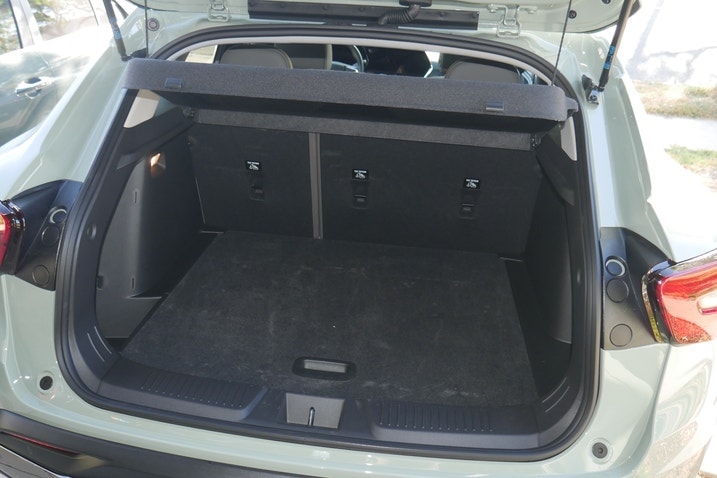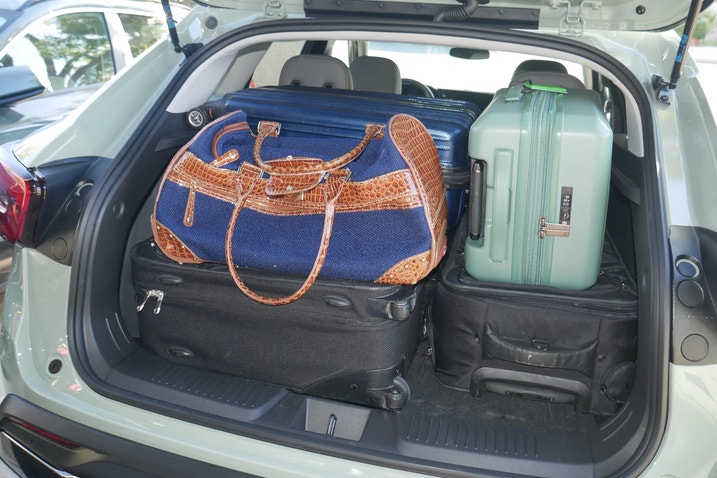- Chevy says the Trax has 25.6 cubic feet of cargo space.
- That's one of the largest volumes in the subcompact segment.
- Our real-world test shows how it really compares.
Chevy Trax Cargo Test: How Big Is the Trunk?
The specs say 25.6 cubic feet, but how much stuff is that, really?
The Chevrolet Trax has 25.6 cubic feet of cargo space behind its back seat, making it one of the most luggage-friendly subcompact SUVs. Only the Ford Bronco Sport (32.5 cubes), Kia Seltos (26.6 cubes) and front-wheel-drive Volkswagen Taos (27.9 cubes; the AWD version has 24.9) have more. Even Chevy’s somehow-more-expensive Trailblazer has less, at 25.3 cubic feet.
OK, all those numbers are swell, but how does any of that translate into actual stuff? Great question. To answer it, I’ve stuffed the same six suitcases from my garage into about 175 vehicles from every possible segment for seven-plus years now. Along the way, I’ve discovered that cubic-foot volume measurements don’t come close to telling the full story or often don’t provide the accurate apples-to-apples comparison you’d expect. I’m now bringing these tests home to Edmunds where the idea for them started in the first place. Batter up, Chevy Trax.
Behold! The Chevy Trax cargo area in all its glory. Before trying to stuff all the bags from my garage inside, though, let's talk about two key elements that affect that capacity.
Let's start under the cargo floor. The good news: There is a spare tire lurking under there, which is far from a guarantee these days. You're often lucky to get a can of goo and a prayer.
Unfortunately, note how much space there is between where the floor rests and both the tire and the surrounding body work. In many SUVs, this sort of residual space provides the opportunity for a dual-level cargo floor. Basically, the upper level (not unlike the Trax's only floor level) is in line with the folded seatback height, providing one flat-ish continuous surface when the seats are down. The lower level provides the most possible space with the seat up, which is exactly what this test, um, tests.
As the Trax doesn't utilize this underfloor space, it is therefore leaving some cargo capacity on the table.
The second item to consider is the Trax's cargo cover. It is a rigid hatchback-style unit. I always do these cargo tests with and without such cargo covers in place. Why? Imagine you've gone to the airport to pick someone up. You get there and realize that (1) you forgot to take out the cargo cover or (2) your friends brought way too much stuff. Either way, there's nowhere to put the cargo cover. Alternatively, you can think of it as, "How much can I keep hidden from prying eyes?"
OK, that sets things up pretty well for the two tests that are about to happen.
But first, here's some nice boilerplate information about the bags I use and their dimensions. There are two bags you'd definitely have to check at the airport: Big Gray (26 inches long x 16.5 inches wide x 12 inches deep) and Big Blue (26 x 16.5 x 10). There are three roll-aboards that usually fit as carry-on: Medium Tall (24 x 14 x 9), Medium Wide (23 x 15 x 9) and the smaller Green Bag (21 x 14 x 9.5). Finally, there's everyone's favorite Fancy Bag (21 x 12 x 11), a medium-sized duffle.
With the cargo cover in place, the Trax can fit the two largest bags, the Medium Tall carry-on and the slightly smaller Green Bag. The cargo cover was dislodged from one of its rear posts and rested upon the big bags, but that doesn't matter. The cover stayed in place and the liftgate closed.
This is a better result than the similarly sized Buick Envista could manage under its cargo cover, which is clearly mounted a few whiskers lower. I couldn't fit the Green Bag in there.
This is a worse result than the Kia Seltos, which could fit all but the Fancy Bag under its cover. The Trailblazer, Bronco Sport and VW Taos I tested did not come with their available cargo covers.
OK, now let's get rid of the cargo cover and load 'er up.
Bingo! All six bags fit in the back of the Chevrolet Trax when the cargo cover is removed. Importantly, rear visibility was still maintained and nothing could fly forward into the cabin — two key safety elements I take into account with every cargo test. That's why I don't load to the roof.
All of these bags also fit in the Envista. It was a harder load in the Buick that required a haphazard Tetris formation, but a key conclusion is that the Envista's cargo area is longer, which partially offsets the Trax's taller, less raked roofline. Since much of the Trax's cubic-foot advantage is above the seatback line, the practical difference between Buick and Chevy isn't as great as the specs suggest.
Now, as the numbers suggested, the Trax does indeed have a more useful cargo area than the Trailblazer, which was harder to load and had the Fancy Bag grazing the roof (visibility and fly-forward safety still OK). The Trailblazer offers a fold-flat passenger seat for really long items while the Trax does not, but that's its only advantage.
As for those subcompact SUVs with greater on-paper capacity, the Kia Seltos was in fact better with the cargo cover in place and removed. It had room left over for a small 20 x 10 x 10 duffle bag in addition to the standard six. The front-wheel-drive VW Taos would have had enough room for a second Fancy Bag. The Ford Bronco Sport could handle an extra roll-aboard and duffle bag, an amount consistent with compact SUVs.
So, in this case, the numbers are accurate in terms of ranking these subcompact SUVs in terms of capacity. They often aren't, which we'll be seeing in future tests.










 by
by  edited by
edited by